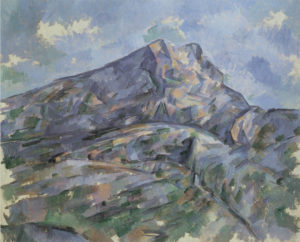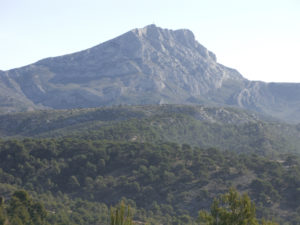R902 – La Montagne Sainte-Victoire vue du bosquet du Château Noir, vers 1904 (FWN357)
Pavel Machotka
(Cliquer sur les images pour les agrandir)
That this is a late landscape by Cézanne is evident a first glance from the patches of color that compose the painting. However, a more patient look reveals something deeper and more individual than a mere sense of recognition. The patches are not a style: they vary considerably between the various surfaces of the subject, as if they were designed to describe the particular characteristics of each. They are long and gently inclined in some parts, short and stubby in others, and apparently randomly set down in still others; yet together they create an articulated whole, present a perfectly clear space, and convey a sense of constant movement.
The painting is in my view an extraordinary work when viewed in its own terms, yet a study of the site reveals much about the logic of Cézanne’s touches.
We find that Cézanne painted in the morning, when the south-facing face of the mountain was just touched by the sun and took on a pink cast, and he was close enough to the nearby hill to see its texture of trees and the shadows they cast at the very same hour. The raking light on the mountain, and the long, parallel shadows of the trees, both record Cézanne’s experience and form the painting’s composition. We see now a more complex meaning in the long patches: they not only describe the convex shape of the hill and echo the back of the mountain, but suggest the painter’s experience of its texture.
The face of the mountain, scraggly at this hour, becomes a jumble of short, hatched touches, enough of which point down to the right to strengthen the balance. And a progression from the greens closest to the painter to the grey-blues farthest away mirrors the site exactly, while the pink cast completes the color spectrum. The painting would be the same masterpiece without the photograph, but with it, we can better understand the logic of Cézanne’s sensations.
Source: Machotka, Cézanne: The Eye and the Mind.
Cette toile a inspiré l’artiste américain Marsden Hartley (1877-1943) :
![Marsden Hartley Mont Sainte-Victoire, 1927 [pink mountain] il on canvas 32 x 391⁄2 inches. Private Collection of Elaine and Henry Kaufman](https://www.societe-cezanne.fr/wp-content/uploads/2017/01/Hartley-Mt_Saint_Victoire-pink-300x243.jpg)
Marsden Hartley
Mont Sainte-Victoire, 1927 [pink mountain]
Oil on canvas
32 x 391⁄2 inches.
Private Collection of Elaine and Henry Kaufman
![Marsden Hartley Mont Sainte-Victoire, 1927 [red mountain] Oil on canvas 20 x 24 inches. Private Collection, courtesy of Gerald Peters Gallery. Photo courtesy of Gerald Peters Gallery, NY](https://www.societe-cezanne.fr/wp-content/uploads/2017/01/Hartley-Mt_Saint_Victoire-red-300x243.jpg)
Marsden Hartley
Mont Sainte-Victoire, 1927 [red mountain]
Oil on canvas
20 x 24 inches.
Private Collection, courtesy of Gerald Peters Gallery.
Photo courtesy of Gerald Peters Gallery, NY
The American artist Marsden Hartley greatly admired the work of Paul Cézanne. Even though Cézanne had died in 1906, Hartley traveled to southern France in 1925 to live in the countryside that Cézanne loved. When he first saw Mont Sainte-Victoire, he said, “I couldn’t believe my eyes for what I saw in the way of dignified beauty…” He rented lodging on the same estate where Cézanne had had a studio, affording him the same view of the magnificent Mont Sainte-Victoire that had inspired Cézanne. Hartley thought of himself as a realist and intended to paint the mountain as most people would see it. But in the strong southern light, he found the mountain “full of hypnotic attraction” and began to express his feelings about the mountain through color.
Marsden Hartley was captivated by the reddish color of the earth around Mont Sainte-Victoire, comparing it to the vivid colors of stained glass windows. He wrote, “Such color exists nowhere outside of the windows of Chartres & Sainte-Chapelle—the earth itself seems as if it were naturally incandescent & seems fired from underneath somehow—yet withal so restrained and dignified.”[1]Hartley in Marsden Hartley: The Biography of an American Artist by Townsend Ludington, (New York: Cornell University Press, 1998), p. 178.
Références
| ↑1 | Hartley in Marsden Hartley: The Biography of an American Artist by Townsend Ludington, (New York: Cornell University Press, 1998), p. 178. |
|---|



